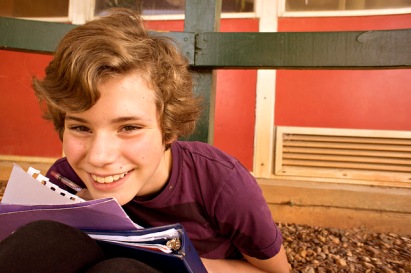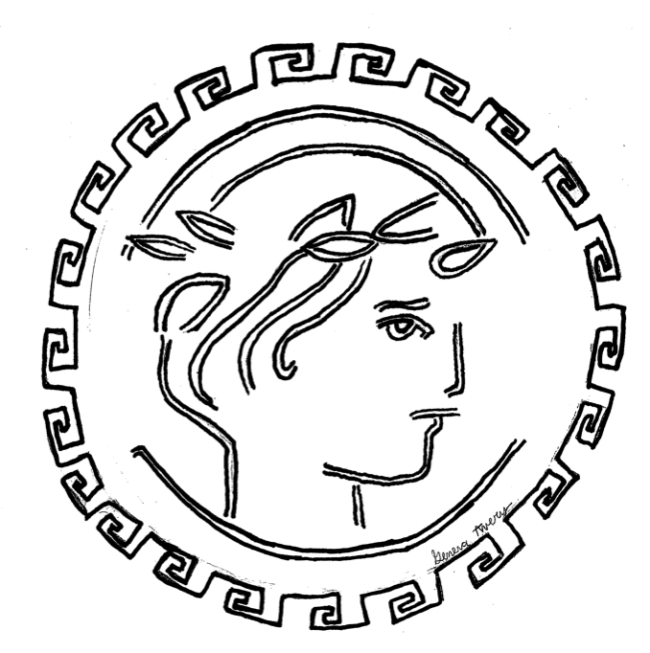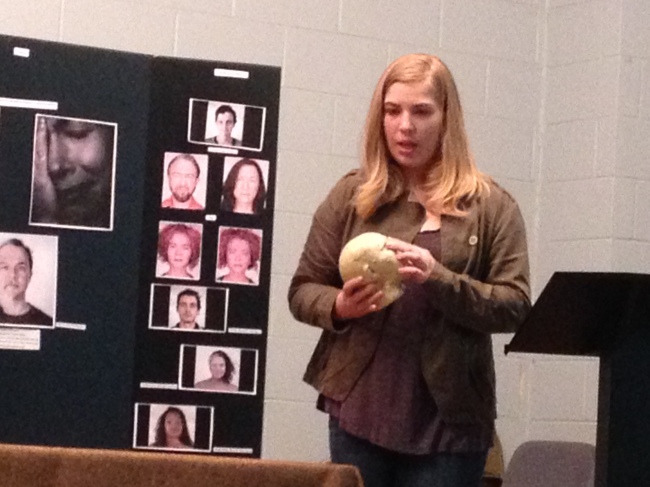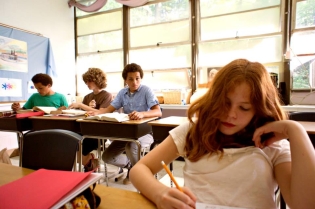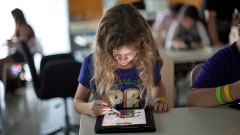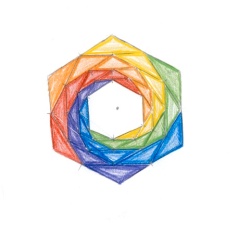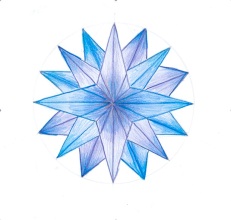The following article was compiled by AWS Class and Certified Waldorf Grades Teacher, Michelle Lucas, for her 6th grade class parents. It was included in the end-of-year evaluations packet for each student. The beginning of it was published in the June/July issue of the school’s newsletter, the AWS Awareness.
For a quick look at what was covered, click on any of the following subjects: History, Physical Sciences (including Astronomy, Acoustics, Light, Magnetism, Mineralogy, and Geology), Mathematics (including Geometric Drawing, Economics, and Algebra), Language Arts, and a Waldorf rite of passage, the Squire’s Challenge.
End of Year Report – Sixth Grade – 2013/2014
Teacher: Michelle Lucas
The development of each human being can be viewed as a series of metamorphoses. In the first six years, the young child strives to master his or her body by sitting up, crawling, walking, and eventually running and leaping forward. The loss of the first teeth signals a new level of development. As particular physical milestones are reached at this time, the six year old has energy available for the unfolding of the memory and the formation of healthy rhythms of learning and is ready for first grade. Around the age of nine, another transformation occurs. The child leaves behind their dreamy immersion and is awakened for the first time to his or her self as separate from their world. At this time, he or she begins the process of leaving behind childhood belief in fairy tales and magic, and moves toward a new period of growth and maturation. At the age of eleven, the sixth grader experiences another fundamental transformation.
This year the sixth graders stood on the cusp of two worlds. Faced with the ability to imagine their own future and feel their own individuality, some eleven-year-olds were tentative and reluctant to leave behind the safe and often light-hearted world of childhood. Others embraced this new world, ripe with opportunities, and sought the freedom to run headlong into their future, sometimes finding themselves in situations for which they were unprepared. They emerged from the dreamy consciousness of the myth and fairy tale ready to learn about themselves and the world in which they live. Their bodies were also changing and developing. They began to take on an angular and often slightly awkward appearance. They did not seem to feel at home or comfortable in their own bodies. The presence of hormones became apparent in the physical changes and the emotional lability of the sixth graders.
In this remarkable time, the students, no longer children but not yet adolescents, often still retained much of the gentleness, openness, and playfulness of childhood along with the new, unfolding cognitive abilities. Feeling their separation from the world and seeing themselves as individuals, they cast about to discover their identities. They were more awake and curious about the world around them than ever before. They were full of questions and began to show the mental capabilities for fully grasping cause and effect, truly understanding the temporal connections between one event and another, and extrapolating from one experience to another. Slowly and carefully, in the way they made their first steps, the sixth graders were ready to move into the world of abstraction and concepts. The curriculum of the sixth grade was designed to meet these new cognitive abilities providing appropriate exercises designed to strengthen and develop the maturing mind without overtaxing.
The material presented this year was extensive and broad. The sixth graders were ready to explore the world and capable of moving much faster and taking in a great deal more information than in the previous years. Main lesson blocks covered history, physics, physical sciences, and mathematics. Language arts were included in all blocks. For the first time, students received grades on their main lesson books and class participation. At the end of each main lesson block, they were given a test on the material presented during the block. This was a learning experience for the sixth graders. It was presented to them as a process, and I met with them individually to answer questions regarding their grades and to offer guidance for improvement. These evaluations provided valuable feedback for the students. They seemed ready and able to use this information to make improvements. Below, you will find a detailed description of the material presented in sixth grade.
I. History
Over the course of three history blocks this year, we studied a period of 2000 years, beginning with the founding of Rome in 753bc and concluding at the start of the late medieval ages around 1300 ce. It is noteworthy that a significant transition from the myth and legend of ancient history to the written records of more modern history occurred within our studies this year. During this period of development, the sixth graders began to have a stronger sense of time, past and present. They begin to consider their own future in earnest and dream of the possibilities that life might have in store for them. It was a time when they could begin to learn from the history of others. The material presented was filled with dualities and polarities, ripe with opportunities for making comparisons and considering differences and similarities.
We began with Virgil’s Aeneid, which described the travels of the Trojan, Aeneas, who following the destruction of Troy by the Greeks, traveled to the land of Italy where his ancestors founded Rome. We continued with the legend of Romulus and Remus, the period of the seven kings, and the founding of the Roman Republic. Through stories of famous Roman figures, exploration of Roman architecture, clothing and food, and examples of Roman government and legal practices, the students gained an understanding and a feeling for the values and culture of ancient Rome. The period of the Roman Republic was brought to life for the students through biographies of famous leaders, stories of the Punic Wars and Hannibal’s epic journey though the Alps, and maps and tales of the incredible expansion of Rome. This period of study concluded with the life and, of course, the death of Julius Caesar.
Within the time of the vast Roman Empire, whose inhabitants valued power, strength, domination, and worldly riches, we considered the life and teachings of Jesus. We compared these stories and ideals to the values of the Romans. Our second block, covering the rise and fall of the Roman Empire, was told through stories of the lives of many Roman Emperors. Some of these men were extremely crazy. The students particularly loved the stories of Caligula, who allegedly had dinner parties for his horse and made plans to have his horse appointed as Consul. Needless to say some of these stories depicted humanity at its worst. During this period, students also learned about the rise and spread of Christianity throughout the vast Roman Empire.
 Our final history block began with stories about the Germanic tribes, who inhabited Europe after the fall of the Roman Empire. Differences in the values of these two cultures were explored as we began our studies of the Medieval Ages. We studied the principles and workings of the Feudal System, the duties of monastic life, the process of becoming a knight, and life in the medieval cities. We considered the rise of kings and leaders such as Charlemagne, the first Emperor of the Holy Roman Empire. During this block the students learned about the life of Muhammad and the religion of Islam. The students learned that Islamic culture during the Middle Ages valued learning about the world, and members of the Islamic faith made important contributions to science, medicine, astronomy, and mathematics. We concluded with stories of the crusades and the ways in which they opened the European people of the Middle Ages to new thoughts and ideas.
Our final history block began with stories about the Germanic tribes, who inhabited Europe after the fall of the Roman Empire. Differences in the values of these two cultures were explored as we began our studies of the Medieval Ages. We studied the principles and workings of the Feudal System, the duties of monastic life, the process of becoming a knight, and life in the medieval cities. We considered the rise of kings and leaders such as Charlemagne, the first Emperor of the Holy Roman Empire. During this block the students learned about the life of Muhammad and the religion of Islam. The students learned that Islamic culture during the Middle Ages valued learning about the world, and members of the Islamic faith made important contributions to science, medicine, astronomy, and mathematics. We concluded with stories of the crusades and the ways in which they opened the European people of the Middle Ages to new thoughts and ideas.
II. Physical Sciences
As mentioned earlier, the sixth grade students demonstrated a new level of consciousness, showing great curiosity about the world around them and new cognitive abilities. Feeling themselves as separate from the world, they were ready to begin to conceptualize and think more objectively. These changes in development prepared them for studies of the sciences.
This year, we began the study of physics. The approach we took was phenomenological. The students experienced demonstrations that were designed to illustrate various aspects of physics. They were encouraged to hone their observation skills and to practice clearly describing their perceptions and sensations. Our physics blocks focused on sound, light, heat, magnetism, and static electricity. Students observed at least one demonstration each day. When they returned to school, they were asked to describe with detail and accuracy what they observed the previous day. The review questions that were asked were designed to lead the students toward an understanding of their experiences. Students were also introduced to expository writing. During these blocks they were asked to write about demonstrations in a clear, factual, objective way.
Acoustics concepts that were covered in demonstrations included: the sources of sound, the distinction between music and noise, ways of producing musical sounds, ways of changing pitch, tone, and volume, how sound travels through solids, liquids, and gases, and ‘sound made visible’ with the Chladni plate. During this block, we attended a performance of the Symphony Orchestra. We also welcomed guest musicians Opal South on the cello, Mr. Lucas on the guitar, Marley Prichard on the violin, and Natalie Serrag on the ukulele.
We began our study of light and color with an experience of total darkness and the gradual dawning of light. We  considered various sources of light and the idea that light itself cannot be seen unless it is reflected off of another substance. Demonstrations focused on how light travels in straight lines, that the intensity of light decreases with distance, and that light passes through some objects and not others. We studied how colors arise, experienced the spectrum of color created by prisms, and the mixing of primary colors to create secondary colors. Students painted a color wheel with watercolors and experienced the optical illusion of afterimages.
considered various sources of light and the idea that light itself cannot be seen unless it is reflected off of another substance. Demonstrations focused on how light travels in straight lines, that the intensity of light decreases with distance, and that light passes through some objects and not others. We studied how colors arise, experienced the spectrum of color created by prisms, and the mixing of primary colors to create secondary colors. Students painted a color wheel with watercolors and experienced the optical illusion of afterimages.
In our second physics block, we studied heat, magnetism, and static electricity. Students experienced the transfer of energy that we call heat by alternately holding their hands in very warm water, room temperature water, and ice water. They enjoyed observing the creation of heat through combustion, friction, light, and chemical reactions. Demonstrations showed the expansion and contraction caused by heating and cooling solids, liquids, and gases as well as how heat travels through radiation, conduction and convection. They observed convection currents in liquids and gases in demonstrations using smoke from incense and heated colored water within a tank of cooler water. In another demonstration, they found that some solid materials are better conductors of heat than others.
In our studies of magnetism, students were introduced to magnetite and experienced its magnetic properties. They explored with magnets to discover which materials were attracted and which were not. They discovered that magnets have north and south seeking poles and that magnetic poles react to one another. They learned that certain objects could be magnetized and used to make a simple compass. They gained an understanding of how the compass works. They observed the force field around magnets as iron shavings were sprinkled on a piece of paper with magnets beneath it.
Our block ended with a brief encounter with static electricity. Students heard the story of Thales who discovered the phenomena when he was cleaning a piece of amber with a wool cloth. They observed how static electricity could be generated, and how static electricity could be perceived by the senses. They discovered that objects with an electrostatic charge attract and repel one another.
Study of the physical sciences continued with astronomy. The sixth graders were at times overwhelmed and dizzied as we found our place within the stars. Astronomy study began with stories of how the ancients counted time and navigated with the help of the stars. Students learned about the pole star and the circumpolar constellations. They gained an understanding of the rotation and orbit of the earth, latitude, longitude and time zones, the seasons as created by the position of the earth and the sun, the phases of the moon, the constellations of the zodiac, the precession of the equinox, and the planets and our place among them.
Our studies led us from the great heights of the heavens into the depths of the earth. We may have been dizzied by our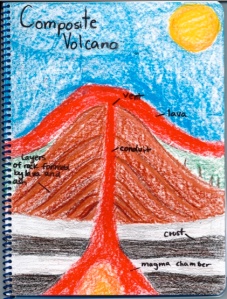 journey into space, but we encountered solid footing and a firm foundation during our study of the rocks and minerals, which make up our home. From the hard granite, made up of quartz, mica, and feldspar crystallized as the magma slowly cooled deep within the earth, to the soft limestone chalk created from the skeletons of microscopic sea creatures beneath the warm, shallow seas of the cretaceous period, mineralogy and geology was filled with polarities. We encountered the world of volcanoes and rocks born of fire. We compared these with the layered, sedimentary rocks formed through erosion. We studied how mountains were formed and worn down. We learned about the great glaciers of the Pleistocene period, which left behind huge granite boulders and carved out ‘u’ shaped valleys, as well as the plants of the Carboniferous period, which formed into coal over millions of years. We learned that all rocks could be transformed through heating or through the application of extreme pressure, changing from granite to marble, from shale to slate, or from sandstone to quartzite. We discovered the amazing habits and shapes of crystal growth and the strength of the diamond, which could be used to cut granite. Finally, we learned that some of the minerals from which the rocks are formed are found within our own bodies, and we need them in order to live.
journey into space, but we encountered solid footing and a firm foundation during our study of the rocks and minerals, which make up our home. From the hard granite, made up of quartz, mica, and feldspar crystallized as the magma slowly cooled deep within the earth, to the soft limestone chalk created from the skeletons of microscopic sea creatures beneath the warm, shallow seas of the cretaceous period, mineralogy and geology was filled with polarities. We encountered the world of volcanoes and rocks born of fire. We compared these with the layered, sedimentary rocks formed through erosion. We studied how mountains were formed and worn down. We learned about the great glaciers of the Pleistocene period, which left behind huge granite boulders and carved out ‘u’ shaped valleys, as well as the plants of the Carboniferous period, which formed into coal over millions of years. We learned that all rocks could be transformed through heating or through the application of extreme pressure, changing from granite to marble, from shale to slate, or from sandstone to quartzite. We discovered the amazing habits and shapes of crystal growth and the strength of the diamond, which could be used to cut granite. Finally, we learned that some of the minerals from which the rocks are formed are found within our own bodies, and we need them in order to live.
III. Mathematics
Mathematics was taught throughout the year at least twice weekly during practice periods. Students were given weekly homework with the goal of practicing and reviewing mathematics processes taught in previous years. In order to strengthen memorization of math facts and calculation speed, students participated in ‘mental math’ exercises several mornings per week and math games during practice periods. Students were taught ‘math tricks’ in order to increase speed and agility in math calculations. Topics reviewed in practice periods and homework this year included the following: math tricks, addition and subtraction with large numbers, long multiplication, long division, short division, the four processes with fractions and mixed numbers, rules of divisibility, and the four processes with decimals. All of the above topics, as well as new material such as percentages were again reviewed in our final math block in May.
 During the year, we had three math blocks. We began the year with a block focused on geometric drawing. Students received a ruler and compass for the first time and were taught the proper use of these tools. With these tools they were guided through the creation of beautiful and precise geometric drawings. They were allowed the artistic freedom to choose how to shade and color these drawings. Through the construction of these geometric forms, students became acquainted with the following geometric terminology: line segment, angle, bisector, perpendicular, parallel, circumference, radius, arc, and diameter. In addition students worked with various shapes: circles, equilateral triangles, right triangles, squares, pentagons, hexagons, octagons, dodecagons. Geometric drawings were constructed dividing the circle into six, twelve, sixteen, and twenty-four equal sections with the aid of the compass and the ruler. Students learned to construct right angles, squares, triangles, perpendicular bisectors, and to divide a line into equal sections. Students became familiar with the use of the protractor and the measurement of angles.
During the year, we had three math blocks. We began the year with a block focused on geometric drawing. Students received a ruler and compass for the first time and were taught the proper use of these tools. With these tools they were guided through the creation of beautiful and precise geometric drawings. They were allowed the artistic freedom to choose how to shade and color these drawings. Through the construction of these geometric forms, students became acquainted with the following geometric terminology: line segment, angle, bisector, perpendicular, parallel, circumference, radius, arc, and diameter. In addition students worked with various shapes: circles, equilateral triangles, right triangles, squares, pentagons, hexagons, octagons, dodecagons. Geometric drawings were constructed dividing the circle into six, twelve, sixteen, and twenty-four equal sections with the aid of the compass and the ruler. Students learned to construct right angles, squares, triangles, perpendicular bisectors, and to divide a line into equal sections. Students became familiar with the use of the protractor and the measurement of angles.
Our second math block, entitled Business Math/Economics, began with understanding and calculating percentages. Students gained were introduced to the processes for writing decimals as percentages and determining percentages. They memorized common fraction to percent conversions. In this block, students also learned about self-sufficient, barter, commodity currency, and monetary economies. The development of our current monetary system was introduced. The banking system was presented from a historical perspective beginning with the system established by the Knights Templar during the crusades in the Medieval Ages. This led us to the topic of our current banking system including the consideration of checking and saving accounts, credit, and interest as it pertains to investments and loans. Students practiced solving word problems that required the calculation of sales tax, tips, commissions, profits, losses, discounts, and simple interest (using the formula I=PxRxT). During this block we took a field trip to a bank and began our own business, selling potatoes to the school. In order to start our business, we researched cost and calculated unit prices to choose our own price for potatoes. We also practiced establishing the value of goods as we set up and ran the Little Elves Store at Holiday Faire. Students used data gathered from these events to create bar graphs and pie charts, which reflected sales.
In May during our final math block, the sixth graders were introduced to the following simple concepts related to Algebra: the use of variables, recognizing simple equations and expressions, solving simple equations, writing expressions in simplified algebraic form, and memorizing the order of operations.
IV. Language Arts
Writing was an integral component of almost all main lesson blocks. Using descriptive, narrative, and expository styles, students were regularly asked to write about material presented during main lesson. Early in the year, the class participated on group writing exercises with guidance from the teacher, and dictations, written by the teacher, were often given during main lesson. As the year progressed, students were more often given individual writing assignments. This year, students were expected to make their own corrections to written assignments using the dictionary. They received instructions and guidance on proofreading with attention given to punctuation, capitalization, spelling, and sentence structure. Students were given weekly vocabulary words pertinent to the current block. During weekly practice periods, students reviewed spelling rules, punctuation rules, parts of speech, and verb tenses. Throughout the year, several spelling tests were given on common sight words and homonyms. Students participated in writing two business letters this year. They wrote to the Dyson Corporation asking for the donation of a vacuum cleaner for the school, and they wrote to the company that manufactured our student chairs requesting that they be repaired.
Students were asked to read and complete assignments on four books this year. They read The Sea of Trolls, The Bronze Bow, a book of their choice written by Rick Riordan, and their choice from the following list: Call It Courage, Julie of the Wolves, The Island of the Blue Dolphins, and The Black Pearl. Various assignments were given such as: writing chapter summaries, creating book covers, drawing pictures of settings and main characters, creating chapter questions for a game about the book, completing open book quizzes, and writing a full book report.
V. Knighting Ceremony
Our year closed with an overnight trip to Camp McDowell where the Squire’s Challenge was concluded with a 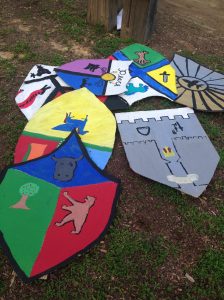 knighting ceremony. This ceremony was designed to be a rite of passage, welcoming these young human beings to a new stage and position. The Squire’s Challenge was devised to encourage self-awareness and empowerment. Hopefully, students experienced their own ability to affect change within themselves. They were encouraged to see themselves as part a larger community and to consider their own responsibilities to the people around them. At Camp McDowell, they participated in team building activities and community service projects on the farm. During the knighting ceremony, each student received letters from their parents, which they read during the forty-minute silent vigil. Following this vigil, they received gifts from their queen (me), and I stood before each of them individually acknowledging the special strengths, talents, gifts, and courage that I have witnessed in each of them. I particularly noted the areas where I have seen each of them overcome challenges and hindrances. Finally, I dubbed each of them knight or lady and they received their papers certifying their new position. We finished with a feast and stargazing. It was a very special and moving event. I believe that the knights and ladies experienced both a feeling of personal transformation and a deeper bonding with their peers.
knighting ceremony. This ceremony was designed to be a rite of passage, welcoming these young human beings to a new stage and position. The Squire’s Challenge was devised to encourage self-awareness and empowerment. Hopefully, students experienced their own ability to affect change within themselves. They were encouraged to see themselves as part a larger community and to consider their own responsibilities to the people around them. At Camp McDowell, they participated in team building activities and community service projects on the farm. During the knighting ceremony, each student received letters from their parents, which they read during the forty-minute silent vigil. Following this vigil, they received gifts from their queen (me), and I stood before each of them individually acknowledging the special strengths, talents, gifts, and courage that I have witnessed in each of them. I particularly noted the areas where I have seen each of them overcome challenges and hindrances. Finally, I dubbed each of them knight or lady and they received their papers certifying their new position. We finished with a feast and stargazing. It was a very special and moving event. I believe that the knights and ladies experienced both a feeling of personal transformation and a deeper bonding with their peers.
****
It has been my pleasure to act as guide and shepherd for these young human beings during this year of transformation and metamorphoses. As we are all aware, change can be challenging, painful, exciting, and magnificent. All of these adjectives apply to our sixth grade year. I learned so much from my students this year, and I look forward to another exciting year of growth and maturation!





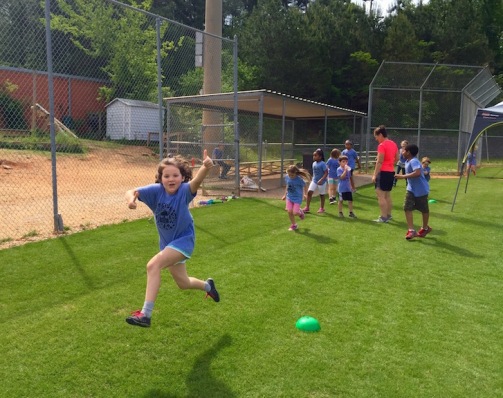
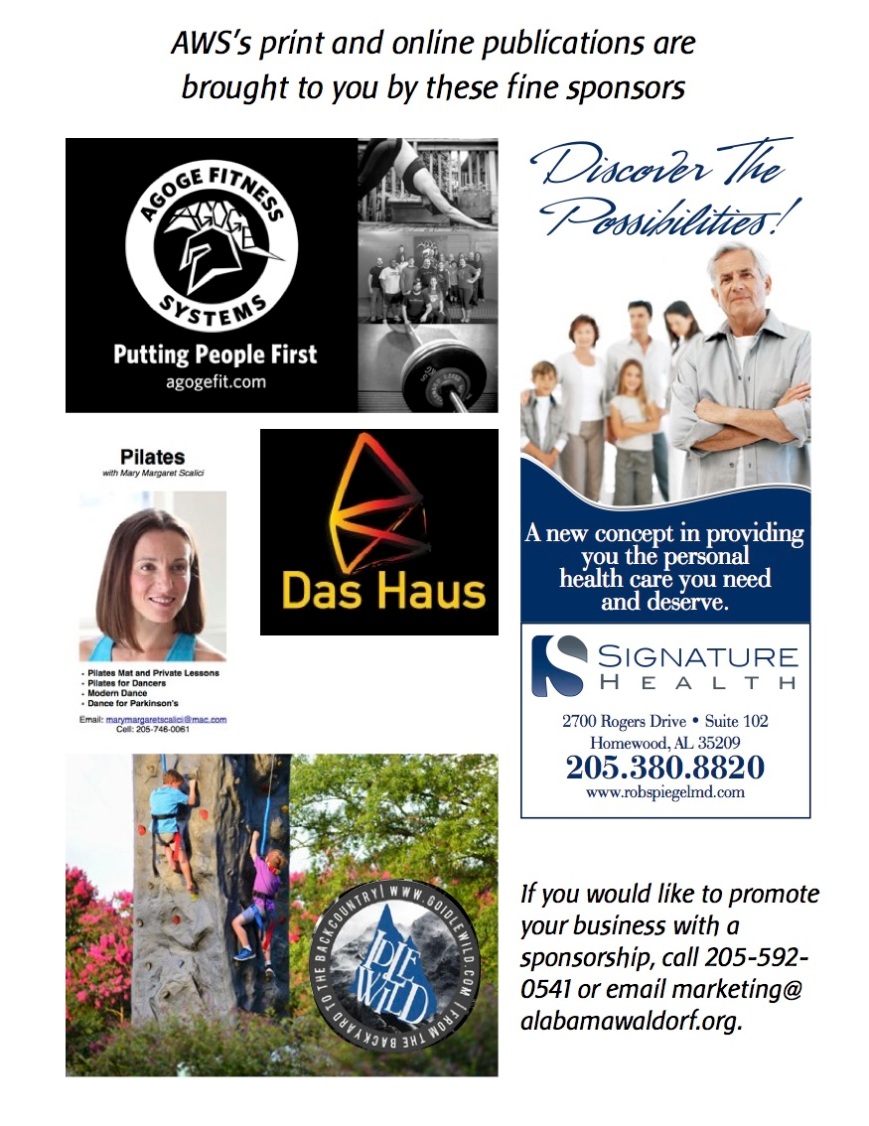

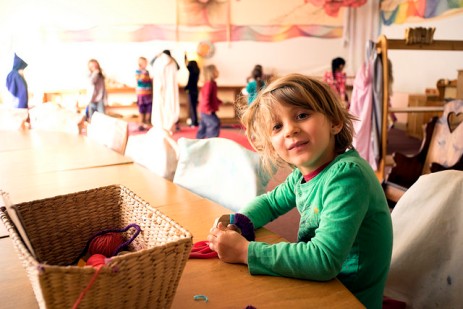 Here in the South, where Waldorf schools are less common, when I tell a new friend that my children are enrolled at Alabama Waldorf School, I often receive comments like, “Oh, isn’t that the school where they discourage reading before 3rd grade?” or, “That’s such a sweet school — but we want something more academically rigorous and challenging for our child.”
Here in the South, where Waldorf schools are less common, when I tell a new friend that my children are enrolled at Alabama Waldorf School, I often receive comments like, “Oh, isn’t that the school where they discourage reading before 3rd grade?” or, “That’s such a sweet school — but we want something more academically rigorous and challenging for our child.” Then, the sprouts begin to push up through the soil. As students move through the lower grades, they learn the forms and shapes and sounds of letters together as a class — first on the chalkboard, and then copied into their own main lesson books. Children learn to write letters before they learn to read words, often moving their arms in the gesture of the letters and drawing beautiful pictures using the letter as a symbol within the drawing (“M” used as the peaks of a mountain, for example). Fairy tales, fables, myths and other stories are recited or read aloud in the classroom every day, repeating and continuing the oral immersion of literary concepts begun in preschool. At the same time, foreign languages are also introduced, immersion-style, through oral and visual exercises.
Then, the sprouts begin to push up through the soil. As students move through the lower grades, they learn the forms and shapes and sounds of letters together as a class — first on the chalkboard, and then copied into their own main lesson books. Children learn to write letters before they learn to read words, often moving their arms in the gesture of the letters and drawing beautiful pictures using the letter as a symbol within the drawing (“M” used as the peaks of a mountain, for example). Fairy tales, fables, myths and other stories are recited or read aloud in the classroom every day, repeating and continuing the oral immersion of literary concepts begun in preschool. At the same time, foreign languages are also introduced, immersion-style, through oral and visual exercises.